Glossika Review And Eye-Opening Interview With Its Founder
 Written byHubert Nagel
Written byHubert Nagel- Read time21 mins
- Comments62
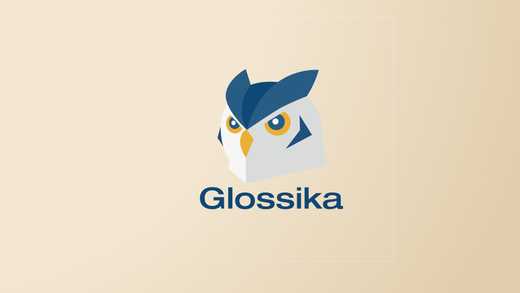
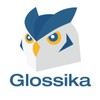
- Highly effective, research-based method
- Totally unique concept
- Natural chunking approach with no explicit grammar
- iOS and Android apps
- May confuse impatient learners
- Unconfirmed reports of minor inaccuracies and errors in translation
If you're someone who believes in learning languages by repetitious exposure to whole lexical chunks rather than entirely unnatural memorization of grammar rules, Glossika is for you. It's a tremendously valuable and unique language resource.
I receive emails asking me to review language products like Glossika all the time.
While most of what I see is great quality stuff, I have to say that there isn’t that much originality out there.
Too many companies are reinventing the wheel, slapping a new label on the same tired content and methods that already exist in other products.
Even though the content may be good, there are few groundbreaking improvements made in the methods being used.
UPDATE: Many new and exciting Glossika language packages have recently been released.
For other comprehensive language learning resources, see the Essential Language Learning Tools section.
I had the opportunity to review the Glossika Russian package while living in Russia
Not long ago I moved to Russia to immerse myself in the language and Glossika became one of the primary resources I chose to work from (I also had tremendous success with the Rocket and Earworms Rapid series).
Glossika uses a highly effective, research-grounded method that is, in my opinion, one of the few tools on the market that I would whole-heartedly endorse as value for money.
There is absolutely no focus on tedious grammar explanations (which as many of you know I reject as being an ineffective way to begin learning to speak a foreign language), and both the content and audio are superb.
Even if you choose not to follow the recommended learning regime outlined in the accompanying e-book, it’s a treasure trove of high quality dialogue material that’s hard to come by.
There are loads of language editions available and more languages are in the pipeline.
I fired off a few questions for Mike Campbell, Glossika’s founder, so that I could really get to the bottom of how Glossika works from the man who created it.
But before I get to the interview, I’m going to give you my own detailed review of the Glossika method. I won’t go into too much detail on the obvious aspects of the site (they have a free trial so you can see those things for yourself).
More importantly, I’d rather talk to you about the method and core product which is what matters.
If you’d like to jump straight to the interview, you can do that here.
Otherwise, here’s the review.
If you’ve tried the Glossika GMS products already then let us know your thoughts in the comment section below.
Why this Glossika review is different
I’ve known and have followed Mike Campbell (Glossika’s founder) for years.
One of the things that I have always promoted heavily in my own language learning method is that you do not need to learn grammar in order to speak a foreign language.
That’s right – no grammar study.
Mike is one of a few prominent polyglots who truly understands this.
He’s been (rightly) emphasizing heavy repetition of patterns over explicit grammar study as key to becoming fluent in a foreign language for a very long time.
Most Glossika reviews you’ll find online are by people with absolutely no background in Applied Linguistics or language pedagogy.
Whatever criticisms they have are usually born out of trying the online Glossika app without actually taking the time to understand what it’s intended for or how it’s intended to be used.
Glossika is NOT your typical Rosetta Stone or Michel Thomas clone.
Not even close.
Its purpose is to get you doing what we do naturally in real life with our first language – listening and repeating over an extended period in limited bursts (through Glossika’s own spaced repetition algorithm ← this is explained below).
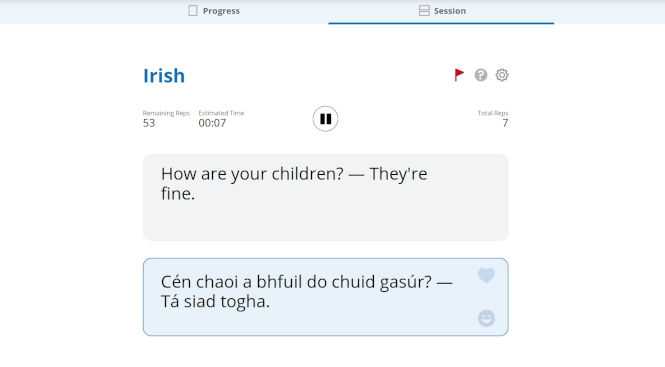
Taking some time to familiarize yourself with its unique approach is vital if you want to get value out of it.
As I said in my Rosetta Stone review a while back, frustration with a unique method often boils down to impatience and wanting immediate results.
A review of Glossika as an online web app and its subscription model
A lot has changed over the past few years since my first Glossika review.
When I first reviewed Glossika years ago, it was a standalone book package you could only order a physical copy of.
Now, like many others (e.g. Babbel and Pimsleur), they’ve gone the route of turning Glossika into a subscription-based, interactive SaaS product (web app).
It’s the same exact content and method.
Benefits of the Glossika web app
Two major benefits arise out of Glossika taking the SaaS model:
- The software tracks your progress and keeps you up to date on that progress.
- One membership gives you access to all languages (this won’t really benefit you if you’re only learning one specific language however).
One disadvantage that this model has (for any product I’ve written a review of including Glossika):
If you cancel, you obviously lose access.
How much does Glossika cost?
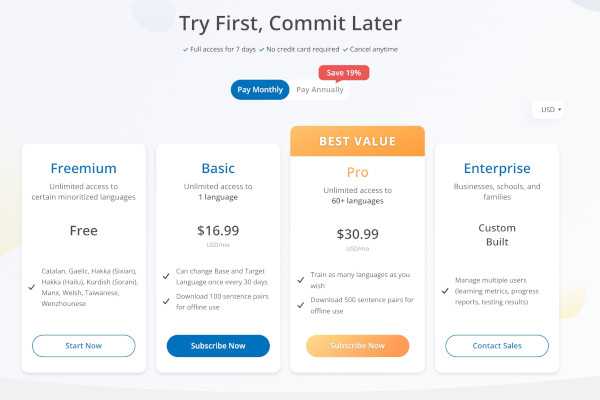
Obviously this means that instead of paying a one-time price for the book and audio physically delivered to you, you get ongoing access to their online web app with a monthly subscription fee.
Glossika pricing options:
Pro for $30.99 a month (unlimited access to 60+ languages)
Basic for $16.99 a month (unlimited access to one language but can be changed once every 30 days)
It’s definitely on the higher end of the scale compared to other language SaaS products, but still reasonable in my opinion.
Glossika review: It gets to the core of what natural language learning is all about
Listen and repeat.
At the end of the day, this is what natural language learning all boils down to.
When we learn our first language as babies, we don’t study grammar. We can’t read.
The only thing we have is our ears along with constant, daily exposure to natural language all around us.
Eventually we begin to repeat what we hear – mostly in chunks or patterns (individual words, phrases and collocations).
In the very beginning, we don’t repeat very accurately either.
It mostly sounds like gibberish and then over time through repeated exposure and practice, it gets clearer and more defined.
This is basically what Glossika is doing.
Mike Campbell insists that you repeat even if your attempt doesn’t sound right.
Eventually it will.
At its core, Glossika is an incredibly basic tool – it really is all about this one fundamental thing:
Listen and repeat through their own spaced repetition algorithm (similar to what you hear in Pimsleur).
Now, compare that to many other language learning products and you realize that what they’re doing is offering distractions while labeling them as features.
Since my initial Glossika review, it does now offer various additional sections on top of the base product:
- Interpretation
- Dictation
- Translation
- Recording feature to compare your voice with a native speaker
But these are all variations of the fundamental, spaced repetition exercise.
It’s still unclear of the precise details of the spaced repetition algorithm that Mike has developed over the years, but a few things are clear:
- An emphasis on syntax over vocabulary
- Short, limited study sessions
- Their importance in relation to sleep cycles and memory consolidation
Let me sum these up briefly.
1. Most language courses and products emphasize the acquisition of words as the foundation of learning.
Take a product like LingQ for example.
Steve Kaufmann has stated many times that vocabulary acquisition is the most important aspect of foreign language learning.
Makes sense, right?
You can’t speak or convey ideas without words.
If you look at just about any language product on the market, it includes an emphasis on memorizing lists of words (usually by topic).
Glossika is more concerned with teaching you patterns.
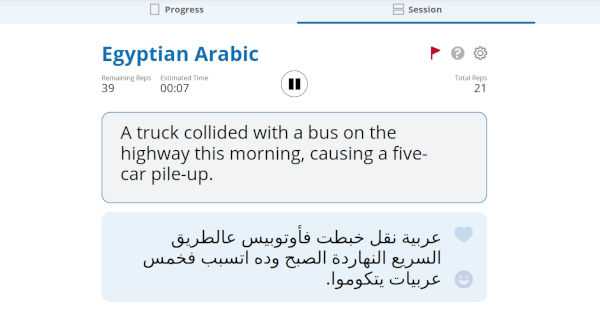
When you start out, you’ll be wondering why on earth they’re getting you to repeat such random sentences.
But it’s intentional.
These are syntactical patterns that Glossika has determined to be the most relevant to the level you’re at and applicable in many other contexts beyond the lesson.
By getting the syntax down, you’ve made it possible to use that syntax with different words in a multitude of different contexts.
2. I’ve talked before about the importance of short, focused study sessions.
Sitting for hours and trying to cram huge amounts of language content is actually detrimental to your learning.
You’ll remember less by trying to learn more.
Glossika has its own precision focus each day of a limited amount of language.
Limited content + high repetition = remembering.
3. Memory consolidation is the process where our sensory or short-term memory moves into our long-term memory.
You experience or encounter many things during your day.
As you sleep on it, you retain certain prominent anchors in your long-term memory.
The ‘next day’ aspect is a part of the Glossika method.
It’s not designed to be crammed in a single day. You’re meant to sleep on it.
By doing so, that small, focused study session becomes ingrained in your permanent long-term memory.
In an age where we want all the answers now, this is a hard aspect to grasp for many people!
iOS and Android Glossika apps
Just a quick note/update to say that Glossika has a popular iOS app available and, at the time of this writing, are about to release the Android version as well.
This is a great option for learning on-the-go, especially since the Glossika method caters to audio learning.
Here are the interview answers I got back from Mike Campbell, founder of Glossika.
I did my best to ask the most pertinent questions on the topic. I have concluding points to my Glossika review at the end of the interview.
Enjoy!
Review interview with Glossika founder, Mike Campbell
1) Can you sum up the Glossika Method (GMS) for this review? Is it based on your own or someone else’s research?
GMS means _G_lossika _M_ass _S_entences, and I don’t think there’s any mystery about practicing a lot of sentences to learn a foreign language.
I have a lot of experience teaching students for over a decade and refining the method and why sentences are better than anything else.
By focusing on language at the sentence level, it makes it easier to learn several things that are not easy to learn by themselves: pronunciation, syntax, vocabulary, and grammar.
Memorizing rules has never let anyone achieve fluency in a foreign language. Only mass amounts of practice has.
Let me touch on each of these.
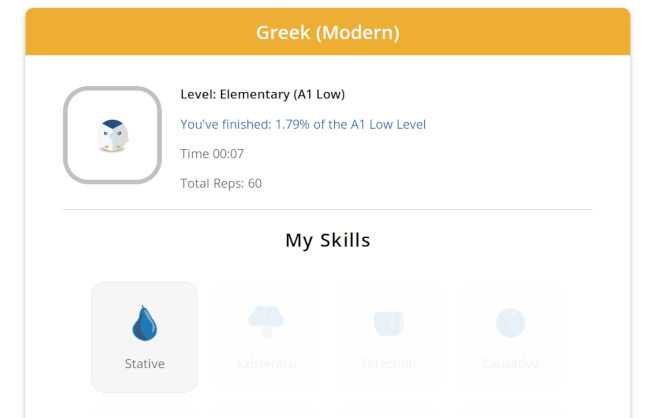
Pronunciation
In languages like English, our words undergo a lot of pronunciation and intonation changes when words get into sentences.
These things may be easier for European students, but for Asian students it can be really difficult.
Likewise is true with languages like Chinese.
The pronunciations and tones we learn from individual words change once they go into a sentence. By following the intonation of a sentence, it’s much easier to sound native rather than trying to say every word with its own tone.
Syntax
Syntax is not an easy subject and there are so many rules to learn.
I find it easiest when I can recognize the parts of speech in a sentence, such as nouns, verbs, adjectives, and just pay attention to what order native speakers put them in.
Some languages like German and Chinese have ‘Subject – Verb – Object’ word order however are pretty strict about moving that order around in certain circumstances.
If you don’t pay attention, or try to create your own sentences with what you think is intuitive, it’ll create bad habits.
Vocabulary
People don’t really understand vocabulary.
Vocabulary only really takes on meaning when it is used appropriately in a sentence or paired with other words, known as collocations. And because of this most dictionaries are not that useful.
The best dictionaries today are those made from databases and are collocation built dictionaries.
Consider the word ‘have’ in these examples:
1) Have him do it. (causative)
2) I’ll have a coffee. (consume/eat/drink)
3) Have you heard from him? (perfect verb).
None of these uses of ‘have’ actually have the meaning that we associate with ‘have’. So if you directly translate the way you use ‘have’ it makes no sense in another language.
After a lifetime in lexicography, Patrick Hanks reached the alarming conclusion that words don’t have meaning.
Grammar
Like I said above, memorizing rules, especially grammar rules does no good for anybody trying to become fluent.
Grammar is really only useful for those who have already acquired a language.
It’s for people who are looking to improve their communication skills and sound more educated or professional.
The only thing we need to be aware of when starting a language is the nature of the language:
Isolating, fusion, agglutinative, or polysynthetic.
Knowing that declensions and conjugations exist is important.
We can’t be ignorant to what exists grammatically in a language, but we can at the beginning be ignorant to what all those grammatical details are and just be aware of them as you encounter them.
2) You mentioned an algorithm Glossika uses – can you explain that?
That’s _G_lossika _S_paced _R_epetition, or GSR for short.
Let me tell you a story about this.
I believe that speaking and listening are two of the most difficult aspects of learning a foreign language.
Most students can’t get used to not using their eyes, whether it’s looking at a text or wanting to know how to spell a word.
We need to train ourselves to become independent of these crutches.
Training our eyes is one skill completely different than training our ears.
Glossika has seen students who have studied English for over ten years and yet still can’t make a sentence in English
They may be very analytical but they can’t create anything that would be considered normal communication.
And the amazing thing I’ve found over years of training students who are dependent on their eyes is that once they let go of the written word their pronunciation and fluency really takes off.
In 2007 I corresponded with a famous psychology professor, Alan Baddeley, the man who discovered the working memory in our brain.
He himself has done a large number of studies of word recognition and memory.
There’s an issue he brought up regarding interference in our young memories.
If we attempt to memorize a list of words that all begin with the same letter, our failure rate is much higher.
I have taken his research and a lot more data he’s given me, and I’ve run over a hundred tests with my students several days of the week.
I’ve found that stimulating the hippocampus with Glossika after each sleep cycle for a total of five times with the same practice routine actually reinforces these memories into long-term memories (in other words practicing the same material over a period of five days).
Not only that, but if you’re repeating the data several times over an hour and then doing that again and again five days in a row using a tool like Glossika, you’ve essentially trained the brain into using new language structure quite effortlessly.
This is providing you’re using that data (for example phrases or vocabulary) and embedding it into new phrases that again will be repeated over a period of five days.
I started using the Glossika method in the classroom from 2007 onward and have refined it several times over the years.
However this has been extremely taxing on me as a teacher – repeating it so many times and fixing the same mistakes.
So I thought that recording it all down into a training system would allow me to reach more people without burning out so easily.
That’s essentially when I designed Glossika Spaced Repetition – GSR for short
I’ve adjusted the training so that Glossika focuses on making you review 40 sentences and introducing 10 new sentences each day, for a total of 180 reps.
For short sentences these daily training files can be completed in less than 15 minutes. For longer sentences the files may run between 20 and 30 minutes.
But in all fairness, beginners don’t want to get burned out that easily.
And if you’re in it for the long haul, then you’ll be able to handle up to a half hour of Glossika training per day.
Since each of our training modules are 1000 sentences, Glossika comes packaged with 100 MP3s for total training between 25 and 35 hours. (NOTE: This is now embedded into the Glossika web app that you can subscribe to).
Our Glossika series from 1 to 3 essentially have about 100 hours of training and 54,000 reps for less than $30.
This far surpasses the training you get in content, length, and spaced repetition from competing products like Pimsleur, Assimil, Rosetta Stone, Babbel, and Memrise.
3) Is the dialogue and course content the same in all Glossika language courses (same sentences and order)?
Yes, the dialogue content is the same in the different languages.
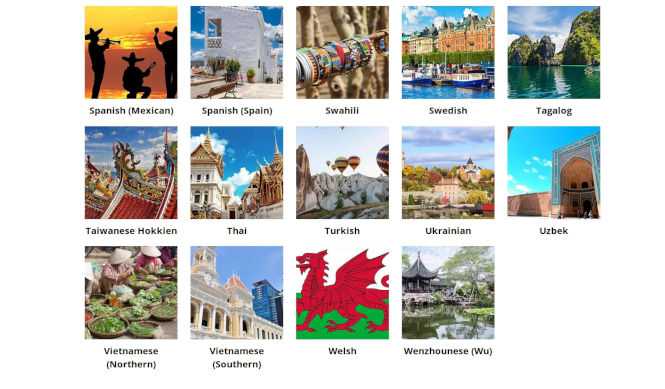
These sentences are indicative of specific syntactic patterns.
Reviewing Glossika, you’ll find that they cover most usage of adjectives, nouns, predicates, and most of the active verb tenses we use in English.
However, the sentences communicate specific ideas and thoughts that tend to fall in these syntactic patterns.
So when a learner focuses on communicating these ideas and recognizing the syntactic patterns, combined with the daily Glossika training I mentioned above, they are essentially acquiring the language naturally.
In Glossika Basic 2, we go on to deal with all the nuances of passive vs active, modal verbs (intentions, assumptions).
Then Glossika Basic 3 goes into conditionals, subjunctives using that, and phrasal verbs.
Some languages that we offer are licensed from other companies or developed elsewhere, so the content will differ.
4) Any planned future releases or Glossika products that you’re working on (perhaps higher level content for existing languages)?
Right now Glossika is working on releasing Basic 1 – 3 for the following languages: Korean, Russian, Thai, Icelandic, Swedish, Portuguese, Italian.
UPDATE (2020): These Glossika editions are now available.
We are also developing some minority languages getting at the moment, such as Saisiyat, Atayal, Amis, Bunun.
Glossika has worked with translation agencies in the past.
For example we paid for full translations of our content into two varieties of colloquial Spanish and a number of other books into Chinese. However, the problem with translation agencies is that they do not have a vested interest in your publications.
Nor do the translators know that their work is getting published in books.
I have to say that despite paying for two versions of Spanish, out of 5000 sentences, only 10 differed and they were not of a colloquial quality that we wanted as they were way too formal.
The agency told us they cannot revise them anymore, so we were stuck with this huge bill for something we couldn’t use.
So there’s always going to be a loss of communication working through agencies.
Glossika changed its approach
We offered cooperation agreements with various native language speakers and this has proven to be very successful.
Now we offer an opportunity to work with and grow with Glossika as a publishing house.
This means that all our translators and recorders get published as authors. They also profit from their publications for years to come.
Most of our collaborators are students or early on in their careers and looking for a way to get established as an author or get some extra income.
Glossika also works with organizations
For example, we have several agreements with organizations in South East Asia for developing those languages and for distribution.
Here in Taiwan, Glossika is working with the company Enspyre which is managed and run by a Swedish entrepreneur who has helped us get our Nordic languages.
Currently our Korean, Portuguese, Italian, and Russian versions are all created by students who just want to be published.
I encourage anybody who speaks a language that is not currently on our list:
If you have good command of English, join Glossika as an author.
We also encourage anybody who has any ideas for publishing a book to contact us as well.
5) Any Glossika success stories with students in Taiwan or other reviews using the method?
As I mentioned above, we have several thousand students in Taiwan who have been using the Glossika method for years.
Right now is the time that we’re expanding into new markets. We offer our products at a very low entry price.
Anybody can try them out and get a feel for how they work.
Glossika will definitely make a supplement to your current studies.
We always welcome feedback from our users.
How I use Glossika to improve language fluency
Hubert here again.
I’ve talked at length many times about the chunking method I developed over the course of my time as a language educator and through my research.
Glossika is still the most effective tool for applying my approach: heavy repetition of lexical chunks.
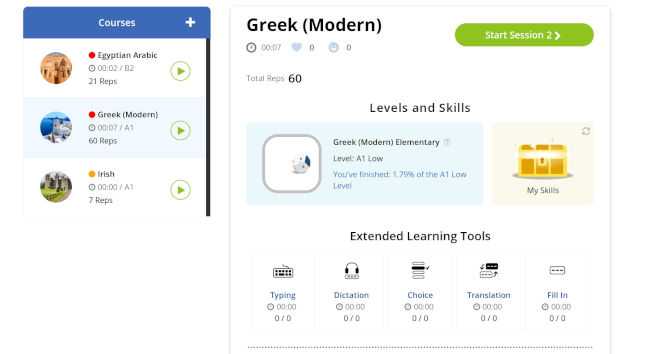
The caveat is that (as I mentioned above), it needs to be explained. Most people have gone through what I believe to be defective education when it comes to foreign languages.
In order to truly benefit from Glossika, you need to be open to having your entire educational experience and preconceived ideas about how languages are learned shattered.
One feature often overlooked in Glossika reviews – unlimited source language variation
With Glossika’s current web app, you can select basically any combination of languages.
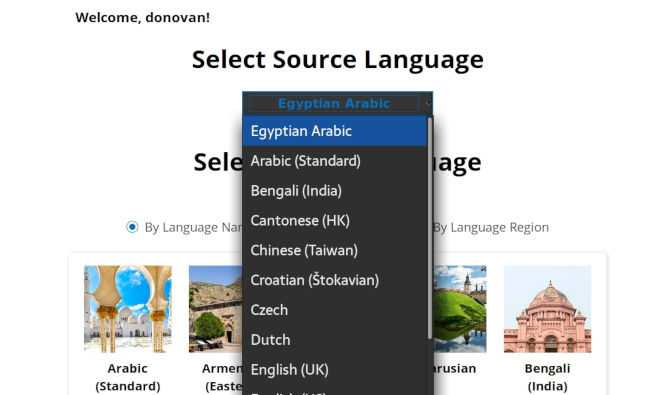
That means that you can basically use any language pair.
So theoretically, you could learn a language like Uzbek through Welsh, or Russian through Hindi!
Unlimited combinations!
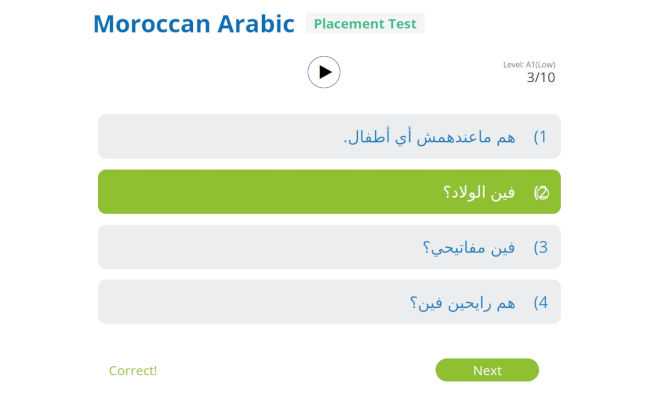
This opens up the software to non-native English speakers all over the world.
Glossika review summary: Where I think it can improve
One minor complaint I have to add to this Glossika review:
I think a new language learner might struggle to understand how to get the most out of it.
I touched on this above.
Glossika has done an amazing job creating a very thorough help section on their site (which details how to use the method) but average learners would probably still not see the value in sentence repetition unless shown exactly how it works. This is probably more of a review of the average, impatient language learner than it is of Glossika though.
The site could definitely benefit from more video or audio tutorials for the uninitiated
Although let me just say – there’s only so much you can do to show how to ‘listen and repeat’!
I’m someone who believes in learning languages by repetitious exposure to whole lexical chunks over time rather than entirely unnatural memorization of grammar rules. For this reason, I believe Glossika is a tremendously valuable resource.
I look forward to more language editions becoming available.
I’ve also heard from my readers that some (not all) language editions contain minor errors and inaccuracies. I did see a couple of minor spelling errors doing a review of the Glossika Egyptian Arabic course.
But for most of the languages I’ve seen however, I’ve yet to come across any major translation or recording problems.
One thing is for sure: Mike Campbell has done a phenomenal job putting the Glossika packages together and has arguably the largest collection covering the most amount of languages (including some very obscure ones) of any program I’ve seen.
Worth a look!
If this Glossika review wasn’t detailed enough (doubtful!), let me know in the comment section.
You can get a detailed breakdown of everything included in the downloadable packages or subscribe on the Glossika website.
Make sure to visit the Essential Tools section of this site too for other alternative language learning resources including Glossika.
 Grab the link to this article
Grab the link to this article